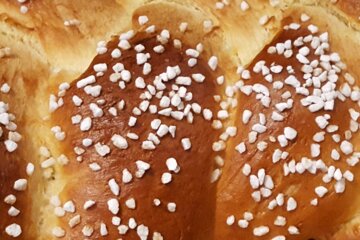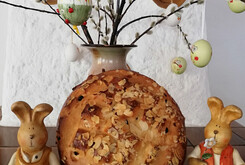THE PERFEKT OSTERFLADEN (Easter Pankcake)
Traditional baking is something that is becoming increasingly rare these days. Not so at the Genussbäckerei und Konditorei Rühl: here you will find exclusively handmade breads, pastries and cakes, and this has been the case since 1933. The headquarters of the family business is in Garmisch-Partenkirchen, with another branch in Grainau. Since its foundation, the business has always remained in family hands. In addition to daily products, the bakery also offers seasonal delicacies. Currently very popular: the delicious Easter flatbread made according to a family recipe. And it is precisely this family recipe that Markus Rühl reveals.
The preparation for the perfect Easter pancake
The yeast-based dough needs two things above all: Warmth and rest. All ingredients for the Easter pancake should definitely be at room temperature before they are used. It is therefore best to take chilled food out of the fridge the night before or first thing in the morning - depending on when you want to bake. Then it's time to get down to business - almost literally: before the real baking of the Easter pancake begins, you have to soak the fruit for the pancake: To do this, pour a mixture of water and rum over the sultanas, candied lemon peel, candied orange peel and slivered almonds and leave to soak overnight.
The next day: Let's go
For the dough, put the flour and salt in a mixing bowl and mix together. Then press a well into the top of the bowl and add the yeast, sugar and a little lukewarm milk. Note: The milk must not be too hot, otherwise it will destroy the yeast cultures. You can leave the whole thing in a warm place for a while so that the yeast starts to work. Only when it is properly activated will the Easter pancake rise nicely and have a soft, "airy" consistency. Then add the remaining ingredients for the dough: butter, eggs, the rest of the milk and vanilla and lemon flavouring. Now it's time to knead, knead, knead. A yeast dough should be worked for at least ten minutes so that all the ingredients are properly distributed. For example, you can use a food processor with a dough hook attachment to knead the base for your Easter pancake, and then use your own arm muscles again at the end. Once the dough has an even consistency, mix in the soaked fruit. Again, make sure they are well distributed. The finished dough is enough for two Easter pancakes. Therefore, divide it into two halves and let them rise for about 30 minutes.
The final touch to the Easter pancake
When the rising time is almost over, you can preheat your oven: at 190 degrees, the Easter pancakes will be perfect. Then mix an ice cream spread, i.e. a mixture of egg yolk and milk, and brush the two patties generously. This will give them a shiny surface after baking. If you like, you can also cut a pattern into them - but this is not a must. Now put the patties in the oven for 25 to 30 minutes on the middle shelf. And voilà: Your perfect Easter pancake is ready and just waiting to be eaten. By the way, it tastes especially good plain, but many people also like to eat it with butter and/or jam.
We wish you lots of fun and a happy Easter!



